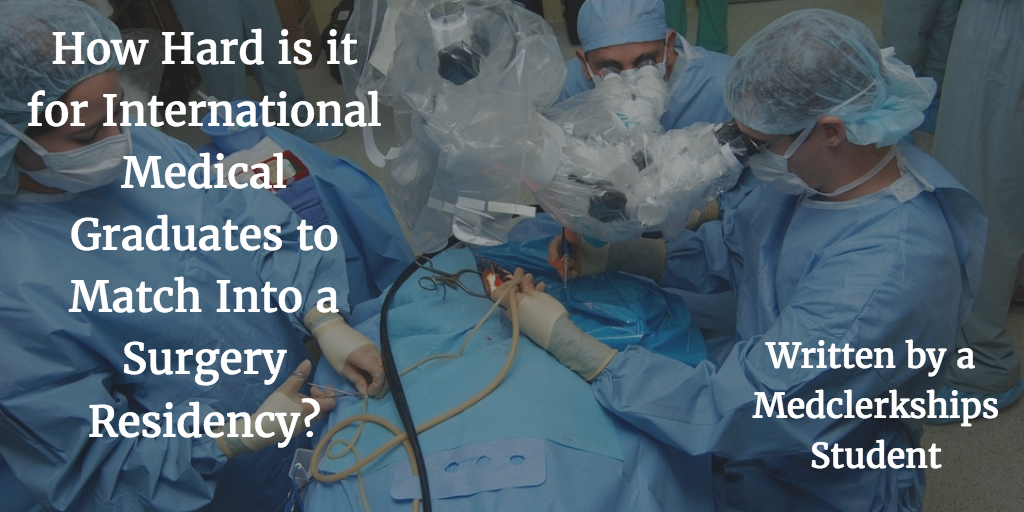
The Match Day is a big dream day for doctors to-be. In the US, there are two different types of applicants, FMG (Foreign Medical Graduates) and IMG (International Medical Graduates, Americans who went abroad for medical studies). Rather than coming to a direct conclusion whether it is hard or not for international medical graduates to get a match into Surgery Residency, let us have a look at few of the facts and figures. Candidates applying for residency in the US have increased exponentially in recent years.
Back in 1975, there was no competition at all, the number of seats were greater than applicants. However, the scenario changed drastically by 2012 where approximately only 24,000 seats were available for 40,000 aspirants. More than 2,700 non-US international medical graduates were lucky enough to reserve seats in Post Graduate Year – 1 (PGY-1) and around 160 graduates in Post Graduate Year – 2 (PGY-2). It was interesting to note the dropping rates for Non-US IMG’s, while the US graduates were successful. The figure shows that the greater amount of applications leads to a lower percentage of Match. In 2003, the Match percentage for IMG’s was 55.7%, which dropped to 48.9% in 2006, further steeping to 40.6% in 2012. It is expected to drop even lower in 2016-2017. It is predicted that by 2018, medical graduates from the US will outperform the number of IMG for available positions (Newton and Grayson, 2003).
Most AMGs (American Medical Graduates) do not have to worry about their residency since more than 90% of AMG match successfully on Match Day. Those who remain, get their positions swiftly following. For IMGs the medical profession is an uphill battle. In 2015, more than 12,000 IMGs attempted for residency, while only having a 50% success rate. Yes, it is hard to get into residency programs. The residencies, Radiology, Surgery, OB/GYN and Orthopedics have been a tough entry for the IMG. (Horvath et.al, 2005). However, it is comparatively easier to Match in Internal Medicine, Psychiatry, Paediatrics, Primary Care and Neurology.
The primary reason for such difference lies within the system in which it works. All students need to go through medical schools in Canada and the US to finish Steps 1 and 2 of USMLE. They can also simultaneously take part in NRMP. However, the IMG has to wait for about 6 months between their graduation and the commencment of a residency program.
Another study depicts that 50% IMG’s are unsuccessful in getting their match in surgery residency, hence adding more numbers to applicants next year and so on. (Newton and Grayson, 2003).
The Residency Program Director sees the IMG with a different eye. They see an IMG as a student who left the US for medical studies because they could not earn a seat a US Medical College. They are not extremely enthusiastic for IMGs. It may be agreed that they studied exceptionally abroad, however these directors will always focus more on the American standard of medical school in which the IMG’s has not experienced.
Apart from this, it is a widely spread assumption that International Medical Graduates are not capable of comunicating easily with their American Patients. Another strong factor that declines the success ratio for Match is the standard of living that occurs in foreign countries abroad. An IMG can have legitamate causations for poor bedside manner in surgery residency. It is not the common trend in foreign countries to consult treatment with patients in a detailed fashion. This however is the custom in US, where patients are kept well aware of all the minute details about medications and other information. Although surgery is a major decision, and the pros and cons should be discussed with patients beforehand, this is not the normal routine in many other countries.
For these many reasons, directors of residency programs keep international medical graduates at bay until and unless they have various extra postions. IMG’s need to work extra hard, need to show extra credibility in order to get a shot, they need to be able to outshine an AMG. If an IMG can develop a wonderful CV, manage to get a significant clinical experience in the US, gain magnificent LORs (Letter of Reccomendation), then one can be able to Match in the coming terms.
Sadly the truth remains that it is getting harder every year for Internal Medical Graduates to get a Match in Surgery Residency or even other fields. But, at the same time the number of AMGs is increasing too, making a good place for a fight for the best candidate.
REFERENCES
Horvath, K., Coluccio, G., Foy, H., & Pellegrini, C. (2004). A program for successful integration of international medical graduates (IMGs) into US surgical residency training. Current surgery, 61(5), 492-498.
Newton, D. A., & Grayson, M. S. (2003). Trends in career choice by US medical school graduates. Jama, 290(9), 1179-1182.
